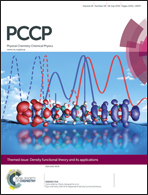ortho-Hydroxylation of aromatic acids by a non-heme FeV![[double bond, length as m-dash]](https://www.rsc.org/images/entities/char_e001.gif) O species: how important is the ligand design?†
O species: how important is the ligand design?†
Abstract
There is a growing interest in probing the mechanism of catalytic transformations effected by non-heme iron-oxo complexes as these reactions set a platform for understanding the relevant enzymatic reactions. The ortho-hydroxylation of aromatic compounds is one such reaction catalysed by iron-oxo complexes. Experimentally [FeII(BPMEN)(CH3CN)2]2+ (1) and [FeII(TPA)(CH3CN)2]2+ (2) (where TPA = tris(2-pyridylmethyl)amine and BPMEN = N,N′-dimethyl-N,N′-bis(2-pyridylmethyl)ethane-1,2-diamine) complexes containing amino pyridine ligands along with H2O2 are employed to carry out these transformations where complex 1 is found to be more reactive than complex 2. Herein, using density functional methods employing B3LYP and dispersion corrected B3LYP (B3LYP-D) functionals, we have explored the mechanism of this reaction to reason out the importance of ligand design in fine-tuning the reactivity of such catalytic transformations. Dispersion corrected B3LYP is found to be superior to B3LYP in predicting the correct ground state of these species and also yields lower barrier heights than the B3LYP functional. Starting the reaction from the FeIII–OOH species, both homolytic and heterolytic cleavage of the O⋯O bond is explored leading to the formation of the transient FeIV![[double bond, length as m-dash]](https://www.rsc.org/images/entities/char_e001.gif) O and FeV
O and FeV![[double bond, length as m-dash]](https://www.rsc.org/images/entities/char_e001.gif) O species. For both the ligand systems, heterolytic cleavage was energetically preferable and our calculations suggest that both the reactions are catalyzed by an elusive high-valent FeV
O species. For both the ligand systems, heterolytic cleavage was energetically preferable and our calculations suggest that both the reactions are catalyzed by an elusive high-valent FeV![[double bond, length as m-dash]](https://www.rsc.org/images/entities/char_e001.gif) O species. The FeV
O species. The FeV![[double bond, length as m-dash]](https://www.rsc.org/images/entities/char_e001.gif) O species undergoes the reaction via an electrophilic attack of the benzene ring to effect the ortho-hydroxylation reaction. The reactivity pattern observed for 1 and 2 are reflected in the computed barrier heights for the ortho-hydroxylation reaction. Electronic structure analysis reveals that the difference in reactivity between the ligand architectures described in complex 1 and 2 arise due to orientation of the pyridine ring(s) parallel or perpendicular to the FeV
O species undergoes the reaction via an electrophilic attack of the benzene ring to effect the ortho-hydroxylation reaction. The reactivity pattern observed for 1 and 2 are reflected in the computed barrier heights for the ortho-hydroxylation reaction. Electronic structure analysis reveals that the difference in reactivity between the ligand architectures described in complex 1 and 2 arise due to orientation of the pyridine ring(s) parallel or perpendicular to the FeV![[double bond, length as m-dash]](https://www.rsc.org/images/entities/char_e001.gif) O bond. The parallel orientation of the pyridine ring is found to mix with the (πFe(dyz)–O(py))* orbital of the Fe-oxo bond leading to a reduction in the electrophilicity of the ferryl oxygen atom. Our calculations highlight the importance of ligand design in this chemistry and suggest that this concept can be used to (i) stabilize high-valent intermediates which can be trapped and thoroughly characterized (ii) enhance the reactivity and efficiency of the oxidants by increasing the electrophilicity of the ferryl oxygen containing FeV
O bond. The parallel orientation of the pyridine ring is found to mix with the (πFe(dyz)–O(py))* orbital of the Fe-oxo bond leading to a reduction in the electrophilicity of the ferryl oxygen atom. Our calculations highlight the importance of ligand design in this chemistry and suggest that this concept can be used to (i) stabilize high-valent intermediates which can be trapped and thoroughly characterized (ii) enhance the reactivity and efficiency of the oxidants by increasing the electrophilicity of the ferryl oxygen containing FeV![[double bond, length as m-dash]](https://www.rsc.org/images/entities/char_e001.gif) O species. Our computed results are in general agreement with the experimental results.
O species. Our computed results are in general agreement with the experimental results.
![Graphical abstract: ortho-Hydroxylation of aromatic acids by a non-heme FeV [[double bond, length as m-dash]] O species: how important is the ligand design?](/en/Image/Get?imageInfo.ImageType=GA&imageInfo.ImageIdentifier.ManuscriptID=C3CP55430A&imageInfo.ImageIdentifier.Year=2014)
- This article is part of the themed collection: Density functional theory and its applications

 Please wait while we load your content...
Please wait while we load your content...
![[double bond, length as m-dash]](https://www.rsc.org/images/entities/h2_char_e001.gif) O species: how important is the ligand design?
O species: how important is the ligand design?